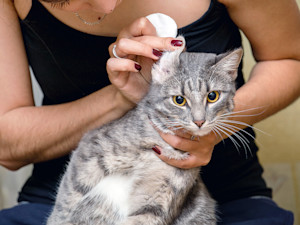Can Your Cat Catch Mange?
That doesn’t seem like a good time...

Share Article
In This Article:
Types of Mange Mange Symptoms Mange Treatments How to Prevent Mange
We’ve all heard the term “mangy cat,” and often picture an undernourished street cat with little to no human contact. But even well-cared-for cats can be diagnosed with mange, and the changes to their skin and coats isn’t always super obvious. What does mange look like on a cat? Let’s discuss.
How to identify different types of mites
Mange refers to an often highly contagious infestation of tiny mites on the skin that inhabit the skin’s surface or deep in the hair follicles. Some species of mites cause obvious visible skin changes, like hair loss, but others are much harder to detect. Mange in cats is much less common than in dogs, but cat parents should still aware of the different types of mites on cats and their signs:
Demodex mites
There are two primary species of demodex mites that affect cats: Demodex gatoi and Demodex cati. Demodex gatoi is more common. The primary sign of demodex in cats is hair loss (especially on the head and face). Other symptoms of demodex in cats include redness, crusting, and hyperpigmentation.

Demodex gatoi mites are contagious and live on the surface of the skin, causing visible hair loss and itching. The hair loss can be localized to the face (especially the eyelids) and neck, but hair loss can also be widespread. Cats with generalized demodex can develop patchy hair loss in multiple areas of their body.
Demodex cati lives in hair follicles and also causes patchy hair loss (most commonly on the face), redness, and scaling. It can also cause ear inflammation and an excess production of dark brown earwax, which is sometimes the only visible sign. D. cati is a normal part of a cat’s skin microbiome, but the population can grow out of control and cause skin disease if there is another underlying health issue. This mite is not contagious and most commonly occurs in young kittens or immunocompromised adult cats, like those infected with FIV, FeLV, diabetes, or cancer.
Notoedres mites
Notoedres cati is the most common cause of scabies in cats. Notoedric mange (feline scabies) is highly contagious and easily spread between cats, so cats in crowded, mulit-cat spaces are at the highest risk. Take note: cats can spread scabies to humans, too.
Notoedres mites cause crusting of the skin, particularly around the ear margins, face, neck and forelimbs. These mites burrow into the skin and trigger intense itching in cats. Other visible symptoms of scabies in cats tend to be associated with the self-mutilation caused by constant scratching and over-grooming. This can include hair loss, excoriations, and inflammation.
Cheyletiella mites
Cheyletiella blakei mites can be spread between cats as well as other species, including humans, dogs, and rabbits. Cheyletiella mites are large enough to be seen with the naked eye and have earned the nickname “walking dandruff” because they can be seen walking across the surface of the skin. Cheyletiella mites often cause scaling, crusting, and small bumps, most commonly found along a cat’s back.
Otodectes mites
Ear mites (Otodectes cynotis) are a common cause of ear infections in cats. Otodectes mites can be spread from cat to cat, as well to other pets and people. These mites tend to inhabit the ear canal, leading to an accumulation of thick, dark brown debris that some determined cats can fling out of their ears with an aggressive head shake.
Cats infected with Otodectes mites also experience symptoms associated with having an ear infection — itching, redness, droopy ears, and self-inflicted scratches on the ear pinnae. Although this mite is most commonly found in the ear, it can also cause itchy red bumps on the neck, rump, or tail.
Sarcoptes mites
Sarcoptic mange is a disease that typically affects dogs, but the mites can occasionally infect cats as well. The mite Sarcoptes scabiei var. canis prefers to live on dogs but can hop on to cats or humans living in close proximity. Cats affected with sarcoptic mange can be itchy and develop scaling, crusting, and hair loss — primarily on the ears, head, neck, tail, and paws. The longer the infection goes without treatment, the more widespread the lesions become.
Symptoms of mange in cats
Although certain types of mange have more distinct symptoms — for example, thick, dark ear gunk is often a sign of Otodectes mites — many symptoms overlap. Common signs of mange in cats include:
Hair loss (patchy)
Itching
Over-grooming and self-trauma (due to itching)
Redness
Small bumps
Ear debris
Thickening of the skin
Hyperpigmentation
How to treat feline mange
Skin issues can make even the happiest cat feel frustrated and miserable, so it’s important to consult with your veterinarian if your cat is developing skin lesions. Additionally, many types of mange are contagious to people and other pets.
Diagnosis
How to treat mange in cats can vary depending on the type of mite involved, so diagnostic testing is important. Most of these mites are microscopic, so your vet will want to collect a sample to inspect under a microscope to identify what type of mite is present. Samples may be collected through skin scraping with a scalpel blade, clear tape collection, a flea comb, or ear swabs.
Treatment
After your vet has determined why your cat is so “mangy,” they can determine the best treatment plan. Common methods of treating mange in cats involve:
Topical mite-killing medication
Systemic mite-killing medication (oral or injectable)
Medicated baths
Antibiotics for secondary skin infections
How to prevent mange in cats
Because many types of cats are highly contagious, preventing exposure to other mangy cats is a key part of prevention. Some monthly preventatives can protect cats from Otodectes (ear) mites, so discuss options with your vet.
Mites like Demodex cati thrive on cats that are immunocompromised, so the best prevention is to help maintain your cat’s overall health. Routine vaccinations, a well-balanced diet, weight management, and reducing exposure to stray cats can help reduce your cat’s r isk of contracting FIV, diabetes, or other diseases.
If any pets in the household are diagnosed with mange, be sure to thoroughly clean any shared bedding or grooming supplies to help prevent spread.
Bottom line
Mange in cats is caused by infestation of a cat’s skin with tiny mites. Cats can catch mange from infected animals or develop mange if they’re immunocompromised. Symptoms include intense itching, hair loss, and crusty, scaly skin. Treatment requires veterinary care with prescription medications. All household pets may need treatment to prevent reinfection.
References
“Diagnosing and Treating Feline Demodicosis.” Veterinary Practice, 10 Apr. 2019, www.veterinary-practice.com/article/diagnosing-and-treating-feline-demodicosisopens in new tab. Accessed 28 Mar. 2025.
DRYDEN.MICHAEL;DRYDEN.MICHAEL. “Mange in Dogs and Cats.” Veterinary Manual, MSD Veterinary Manual, 2018, www.merckvetmanual.com/integumentary-system/mange/mange-in-dogs-and-catsopens in new tab.
Ectoparasites in Cats - American Board of Veterinary Practitioners, 2016 Conference Proceedings.

Dr. Alycia Washington, DVM, MS
Alycia Washington is a small-animal emergency veterinarian with over 10 years of experience based in North Carolina. She works as a relief veterinarianopens in new tab and provides services to numerous emergency and specialty hospitals. She also works as a veterinary writer with a focus on educating pet parents.
Related articles
Why Does My Cat Have Scabs?
And how to help them heal.
![Woman cleaning cat's ear at home.]()
Ear Mites in Cats: When to Worry and Preventative Measures
Uh, ew. But also: Here‘s what you should look out for.
![Woman petting her long haired cat on the sofa.]()
Why Does My Cat Have Dandruff? Common Causes and Treatments
Ever heard of “walking dandruff?” Yep, that’s what we said.
![Portrait of siberian cat with green eyes by the window.]()
How to Prevent—or Treat—Cat Ear Infections
How to prevent an ear infection (and treat one if it’s too late).
![a cat licking a hot spot]()
How to Spot, Treat, and Prevent Hot Spots on Your Cat
Hot spots are so not hot—your cat agrees.
Cat Allergies: Do Hypoallergenic Cats Exist?
If the sniffles are getting you down, don’t stress: You have options.








